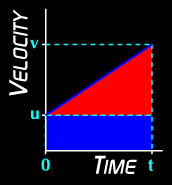Let's look at what the area under the line represents:
So the total area is given by s = ½ (v+u) × t (where s is the letter used for displacement). ½ (v+u) is, of course, just the average velocity. In other words, displacement = average velocity × time! This is nothing new...
|

